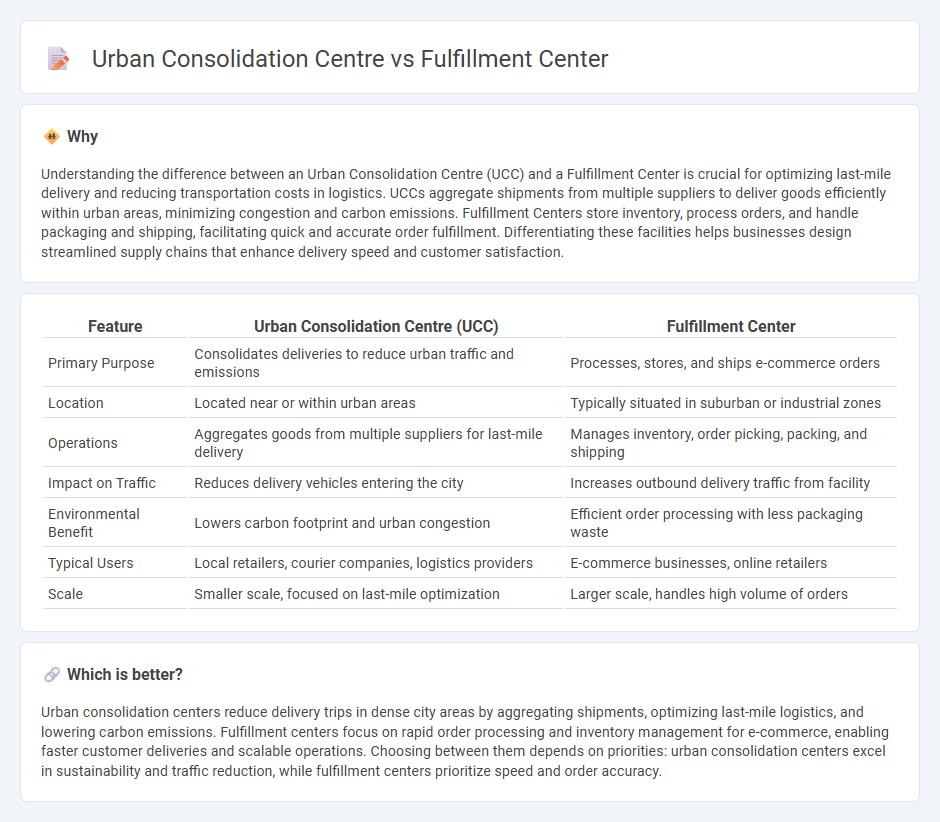
Urban consolidation centers streamline last-mile delivery by aggregating shipments from multiple suppliers to reduce traffic congestion and emissions in city centers. Fulfillment centers focus on storing inventory, processing orders, and shipping products directly to customers, supporting e-commerce efficiency on a larger scale. Explore the distinct roles and benefits of these logistics hubs to optimize supply chain performance.
Why it is important
Understanding the difference between an Urban Consolidation Centre (UCC) and a Fulfillment Center is crucial for optimizing last-mile delivery and reducing transportation costs in logistics. UCCs aggregate shipments from multiple suppliers to deliver goods efficiently within urban areas, minimizing congestion and carbon emissions. Fulfillment Centers store inventory, process orders, and handle packaging and shipping, facilitating quick and accurate order fulfillment. Differentiating these facilities helps businesses design streamlined supply chains that enhance delivery speed and customer satisfaction.
Comparison Table
| Feature | Urban Consolidation Centre (UCC) | Fulfillment Center |
|---|---|---|
| Primary Purpose | Consolidates deliveries to reduce urban traffic and emissions | Processes, stores, and ships e-commerce orders |
| Location | Located near or within urban areas | Typically situated in suburban or industrial zones |
| Operations | Aggregates goods from multiple suppliers for last-mile delivery | Manages inventory, order picking, packing, and shipping |
| Impact on Traffic | Reduces delivery vehicles entering the city | Increases outbound delivery traffic from facility |
| Environmental Benefit | Lowers carbon footprint and urban congestion | Efficient order processing with less packaging waste |
| Typical Users | Local retailers, courier companies, logistics providers | E-commerce businesses, online retailers |
| Scale | Smaller scale, focused on last-mile optimization | Larger scale, handles high volume of orders |
Which is better?
Urban consolidation centers reduce delivery trips in dense city areas by aggregating shipments, optimizing last-mile logistics, and lowering carbon emissions. Fulfillment centers focus on rapid order processing and inventory management for e-commerce, enabling faster customer deliveries and scalable operations. Choosing between them depends on priorities: urban consolidation centers excel in sustainability and traffic reduction, while fulfillment centers prioritize speed and order accuracy.
Connection
Urban consolidation centres (UCCs) streamline last-mile delivery by aggregating shipments from multiple suppliers to reduce traffic congestion and emissions in city centers. Fulfillment centers process and store inventory, preparing orders for shipment to various destinations, including UCCs. The connection lies in UCCs receiving bulk shipments from fulfillment centers to optimize delivery routes and enhance supply chain efficiency within urban logistics networks.
Key Terms
Inventory Management
Fulfillment centers optimize inventory management through centralized storage and advanced warehouse automation, enabling faster order processing and accurate stock control. Urban consolidation centers reduce last-mile delivery inefficiencies by consolidating shipments from multiple suppliers, decreasing inventory holding costs and urban traffic congestion. Explore the benefits of both facilities to enhance your supply chain strategy and inventory management efficiency.
Last-Mile Delivery
Fulfillment centers streamline order processing and inventory management, enabling faster dispatch to customers, while urban consolidation centers aggregate shipments from multiple retailers for optimized last-mile delivery, reducing traffic and emissions in congested city areas. Urban consolidation centers play a critical role in enhancing urban logistics sustainability and efficiency by minimizing redundant deliveries and optimizing delivery routes. Discover more about how these facilities transform last-mile delivery strategies for smarter, greener supply chains.
Order Aggregation
Fulfillment centers handle large volumes of individual customer orders by picking, packing, and shipping directly to consumers, optimizing efficiency through bulk processing and inventory management. Urban consolidation centers aggregate multiple orders from various retailers or suppliers in a centralized urban location, reducing delivery trips and emissions by consolidating shipments before last-mile delivery. Discover more about how order aggregation enhances logistics and sustainability in e-commerce distribution.
Source and External Links
Fulfillment Centers: The Powerhouse for Seamless eCommerce - A fulfillment center is a specialized facility where ecommerce and third-party logistics companies store, process, and fulfill customer orders, handling tasks like inventory management, picking, packing, and shipping to enable efficient order fulfillment and faster delivery to customers.
Fulfillment Center & Warehousing Services: Tips and Tactics - Fulfillment centers serve as hubs for managing seller inventory and fulfilling orders either direct-to-consumer or business-to-retail, outsourcing storage, packing, and shipping to third-party logistics providers to save time and reduce costs.
What is a Fulfillment Center? - Fulfillment centers warehouse products and fulfill both B2B and B2C orders by picking, packing, and shipping items, acting as key logistics nodes for companies selling online across multiple sales channels.
 dowidth.com
dowidth.com